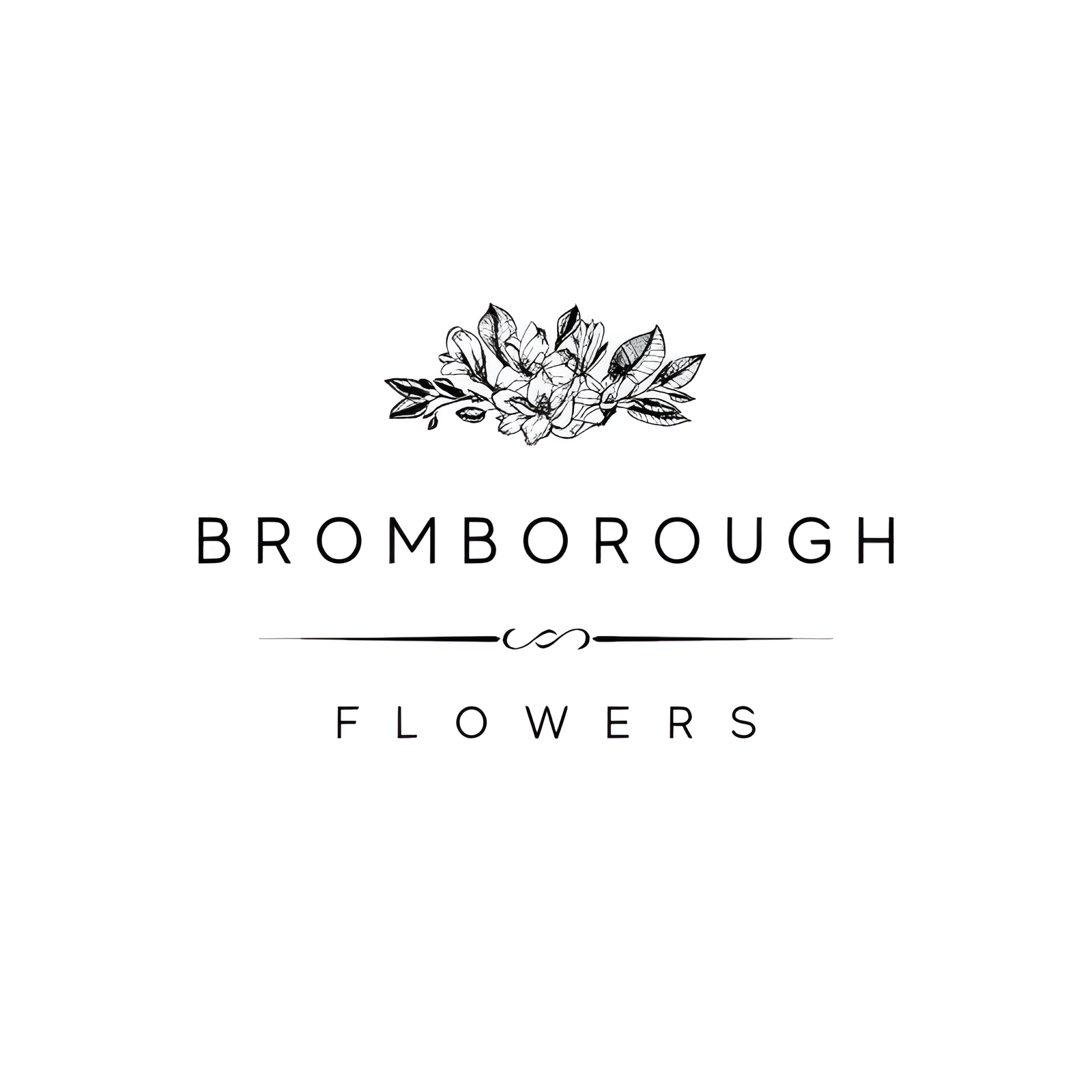The Rhododendron, with its majestic clusters of vibrant blooms, offers a sophisticated and elegant touch to wedding decor. Known for its wide range of colors, including pink, red, purple, white, and yellow, this flower is a versatile option for bouquets and floral arrangements. Beyond its aesthetic appeal, the Rhododendron carries symbolic meanings of beauty and grace, making it a meaningful choice for couples. But what makes this flower not just beautiful, but also significant in different cultures? And how can it be best utilized in wedding ceremonies to achieve the desired ambiance?
Flower Overview
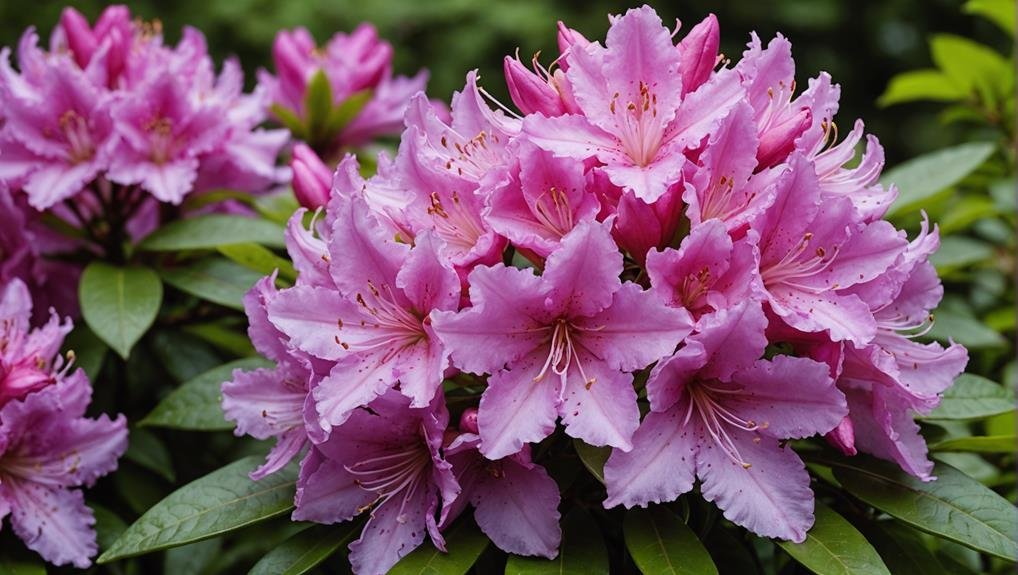
Rhododendrons, recognized for their vibrant and diverse array of colors, are a popular choice for wedding bouquets and floral arrangements. With hues ranging from pink, red, and purple to white and yellow, these flowers add a striking visual appeal to any setting. Their large, showy clusters of blooms make them particularly desirable for creating eye-catching centerpieces and bridal bouquets. Rhododendrons are native to Asia, North America, and Europe and thrive in acidic soil and shady conditions, making them relatively versatile in their growing requirements.
However, when incorporating rhododendrons into wedding decorations, it is important to take toxicity concerns into account. These beautiful plants are toxic to cats and dogs if ingested, posing a risk to pets. Thus, precautionary measures should be taken to ensure the safety of any animals that might come into contact with these flowers during events.
Beyond their aesthetic appeal, rhododendrons carry unique symbolism. Often associated with caution and danger due to their toxicity, they paradoxically also symbolize beauty and elegance. This dual symbolism makes them an intriguing choice for weddings, where they can represent both the delicate balance and the profound beauty found in love.
Physical Description
The large, alluring clusters of blooms characteristic of rhododendron plants make them a standout choice in floral arrangements and landscaping. These flowers are typically funnel-shaped, featuring between 5 to 10 lobes, which contribute to their striking visual appeal. The blooming process of rhododendrons is a mesmerizing spectacle, with buds unfurling into vibrant, multi-lobed flowers that can create a dense canopy of color in gardens or add a dramatic flair to wedding bouquets.
Rhododendrons also boast a distinctive leaf structure. The leaves are usually dark green and leathery, providing a sturdy backdrop that enhances the vividness of the blooms. The leathery texture and rich color of the leaves not only contribute to the plant's aesthetic but also offer a pleasing contrast to the delicate flowers.
Below is a table summarizing key physical characteristics of rhododendrons:
| Feature | Description |
|---|---|
| Bloom Structure | Funnel-shaped, 5-10 lobes |
| Leaf Structure | Dark green, leathery |
| Blooming Process | Buds unfurl into large clusters |
The interplay between the robust leaf structure and the exuberant blooming process makes rhododendrons a versatile and visually appealing option for various decorative uses.
Available Colour Varieties
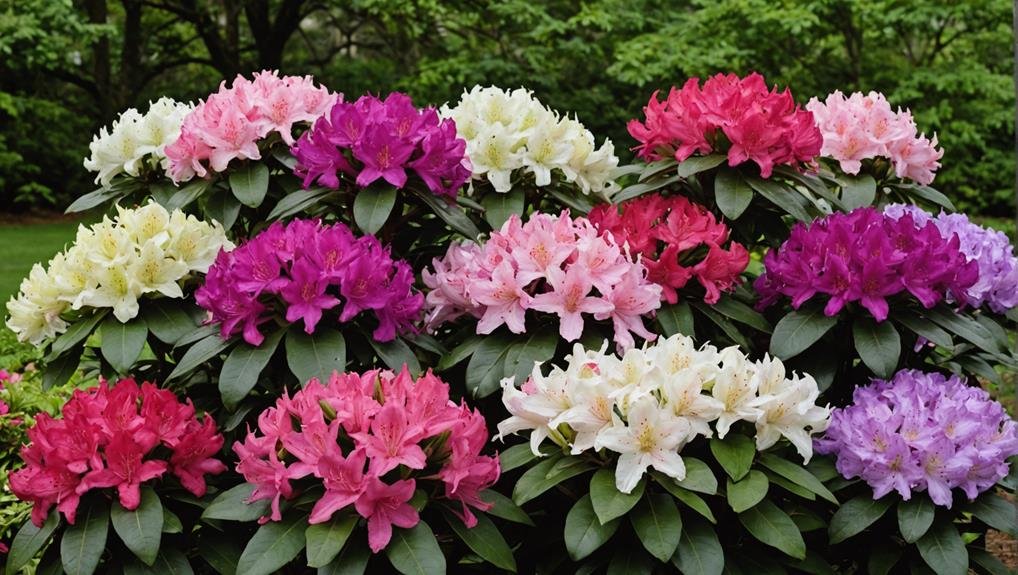
A stunning array of color varieties is available for rhododendrons, ranging from pristine whites to vivid reds and purples. These diverse hues offer immense versatility for wedding floral arrangements, allowing for creative expression that aligns with various themes and color schemes. Popular choices include pale pink, deep red, and lavender, each bringing its unique charm and appeal to the occasion.
Incorporating color psychology, rhododendrons can evoke specific emotions and moods. For instance, white rhododendrons symbolize purity and innocence, making them ideal for traditional weddings. Deep reds convey passion and love, while lavender adds a touch of elegance and grace. The color of rhododendron flowers can also be influenced by soil pH levels, with more acidic conditions producing enchanting blue hues.
Understanding the symbolic meanings of these colors can enhance bouquet pairings and overall wedding décor. Pale pink rhododendrons, symbolizing romance and admiration, pair beautifully with white lilies or roses for a soft, romantic look.
Deep red varieties can create striking contrasts when combined with white or pastel blooms, adding depth to the arrangements. Lavender rhododendrons offer sophistication, complementing a variety of other floral elements seamlessly.
Latin Name and Taxonomy
Derived from the Greek words 'rodon' (rose) and 'dendron' (tree), Rhododendron is a genus within the heath family (Ericaceae) encompassing over 1,000 species. This Latin classification places Rhododendron among the most diverse and expansive groups of flowering plants found in various habitats.
The genus is recognized for its wide array of forms, ranging from diminutive shrubs to towering trees, each contributing uniquely to its ecological and horticultural value.
Taxonomically, Rhododendron holds significant relationships within the Ericaceae family. This family includes other well-known genera such as Vaccinium (blueberries and cranberries) and Erica (heaths and heathers).
The taxonomic relationships within the genus Rhododendron are complex, with species often divided into subgenera, sections, and subsections. This intricate classification underscores the genus's vast diversity and adaptability.
Rhododendrons are celebrated for their showy clusters of flowers, which come in a spectrum of colors including pink, purple, red, white, and yellow. Their evergreen foliage and vibrant blooms make them a favored choice for gardens and landscaping.
Understanding the Latin classification and taxonomic relationships of Rhododendron provides a foundational appreciation for its role in both natural ecosystems and ornamental horticulture.
Geographical Origins
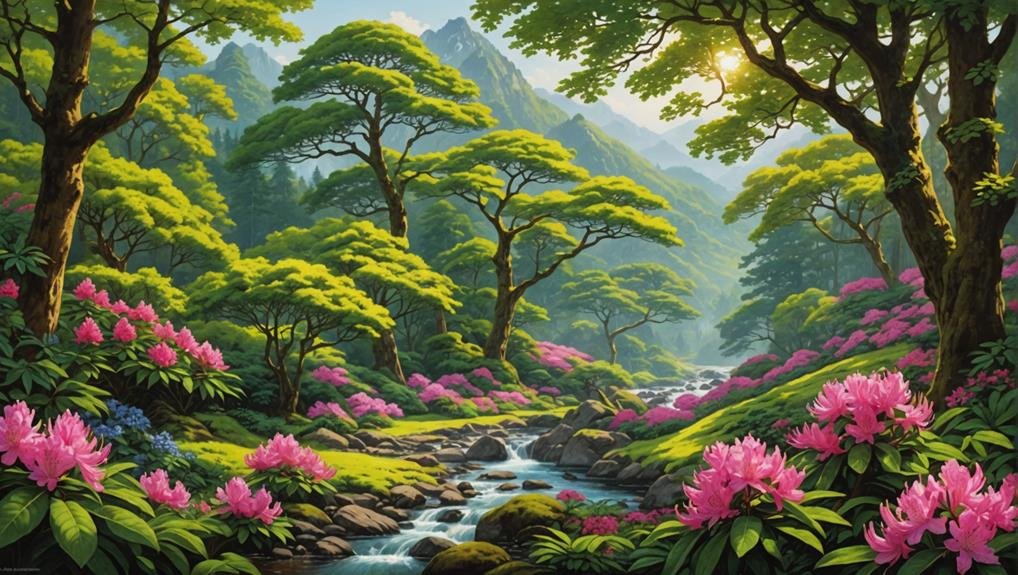
Understanding Rhododendron's taxonomic diversity leads us to explore its geographical origins, which span across Asia, North America, and Europe, with the highest species diversity concentrated in the Himalayas. Native to these regions, rhododendrons thrive in mountainous areas with acidic soils, such as forests, meadows, and rocky slopes. Their vibrant clusters of flowers—ranging in colors from pink and red to purple, white, and yellow—make them a popular choice in horticultural trends.
The ecological impact of rhododendrons is multifaceted. While they contribute to biodiversity in their native habitats, some species have become invasive in non-native regions, threatening local ecosystems. Conservation efforts are essential to managing these invasive species and protecting native plant communities.
| Region | Species Diversity | Ecological Impact | Conservation Efforts |
|---|---|---|---|
| Himalayas | Highest | High biodiversity | Essential for preservation |
| Asia | Moderate | Some invasive species | Ongoing management needed |
| North America | Moderate | Potential invasiveness | Monitoring and control |
| Europe | Lower | Invasive in some areas | Active intervention |
Climate adaptation has enabled rhododendrons to flourish in cooler climates, enhancing their utility in landscaping and gardens. Their evergreen foliage and showy blooms continue to influence horticultural trends. Understanding their geographical origins and ecological roles helps inform sustainable gardening practices and conservation strategies.
Season Availability
When considering seasonal availability, rhododendrons are typically in bloom from late spring to early summer, making them an ideal choice for weddings during this period. Their vibrant colors and large clusters of blooms add an eye-catching element to any wedding bouquet or arrangement. Available in various shades including pink, purple, red, and white, rhododendrons offer a myriad of options to suit different color palettes and themes.
For those interested in DIY arrangements, sourcing options for rhododendrons include local florists and specialized flower markets. It's essential to plan ahead and coordinate with your chosen florist to make sure fresh blooms are available for your special day. Rhododendrons' versatility allows them to be incorporated into various floral designs, from elegant centerpieces to striking bridal bouquets.
Considering unique floral pairings, rhododendrons can be combined with other flowers like peonies, roses, or lilies to create stunning and distinctive arrangements. For bouquet alternatives, consider mixing rhododendrons with greenery or smaller filler flowers to achieve a balanced and harmonious look.
Growing Conditions
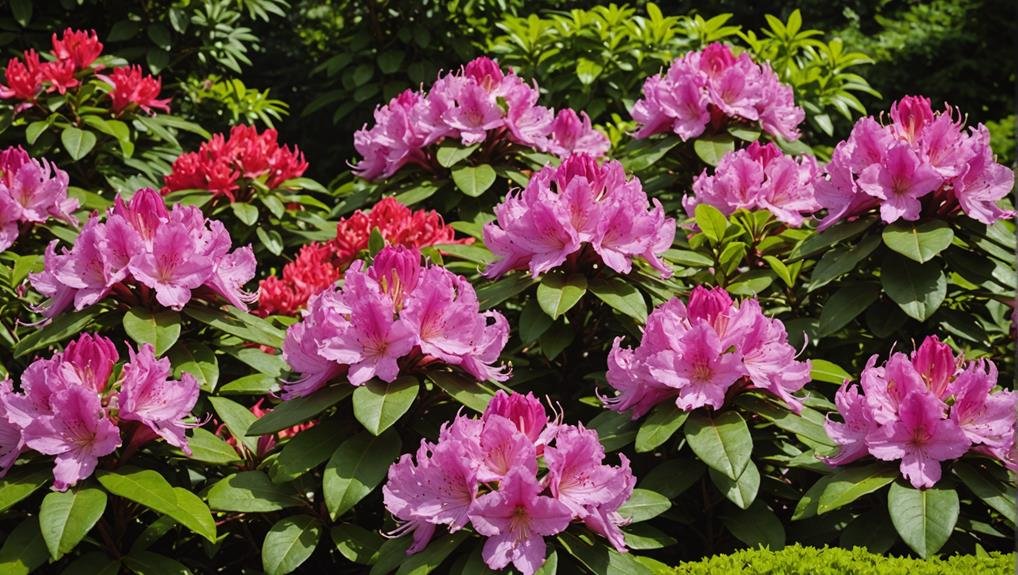
Rhododendrons thrive best in acidic, well-drained soil and partial shade, making these conditions necessary for their best growth. The ideal soil acidity for rhododendrons falls between a pH of 4.5 and 6.0, guaranteeing the plant can access necessary nutrients.
Plant spacing is essential; placing rhododendrons too closely together can hinder air circulation and increase susceptibility to diseases. Aim to space them at least three to six feet apart, depending on the variety, to promote healthy development.
Sun exposure also plays a crucial role in rhododendron care. While they appreciate some sunlight, too much direct sun can scorch the leaves. Ideally, they should receive filtered sunlight or be planted in locations with morning sunlight and afternoon shade. This balance helps protect the foliage while allowing sufficient light for photosynthesis.
Watering frequency is another vital factor. Rhododendrons require regular watering, particularly during dry spells, to maintain consistent soil moisture. However, the soil should be moist but not waterlogged, as overly wet conditions can lead to root rot. Mulching around the base can help retain moisture and regulate soil temperature, further supporting the plant's health.
Proper care in these areas ensures lush, vibrant blooms suitable for any garden or wedding arrangement.
Cultural Significance
How do rhododendrons, with their vibrant blooms and diverse varieties, maintain significant cultural importance across different parts of the world?
In Nepal and Bhutan, these striking flowers are celebrated as national symbols, embodying the natural beauty and rich biodiversity of these Himalayan regions. The symbolic meanings of rhododendrons extend to traditional practices in various cultures.
For instance, in traditional Chinese medicine, the flowers are treasured for their believed medicinal properties, used to treat a variety of ailments.
Rhododendrons also play a notable role in folklore and mythology. In Celtic traditions, these flowers are emblematic of protection and spiritual growth, often seen as symbols of inner strength and resilience. Such associations highlight the deep-rooted cultural rituals that surround the rhododendron, emphasizing its esteemed place in various societies.
Furthermore, the flower's aesthetic appeal and adaptability have made it a favorite in gardens and landscaping globally. The rhododendron's symbolism of beauty, grace, and elegance contributes to its widespread popularity, particularly in contexts that celebrate these qualities.
This multifaceted cultural significance ensures that the rhododendron remains a cherished and versatile element in various traditions and practices worldwide.
Typical Use in Weddings
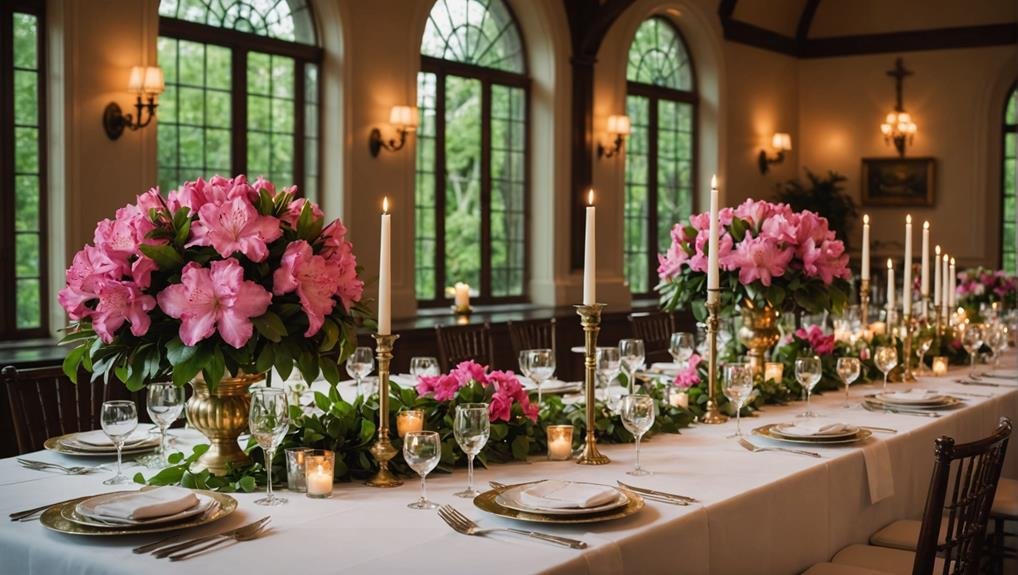
Beyond their cultural significance, the aesthetic appeal and versatile nature of rhododendrons make them a popular choice for wedding décor. These flowers are renowned for their large, showy blooms and vibrant colors, which effortlessly add a touch of elegance and sophistication to any wedding setting. Due to their striking appearance, rhododendrons are frequently incorporated into floral arrangements and bridal bouquets, where they serve as focal points that capture the eye and enhance the overall theme.
One of the key reasons for their popularity is the wide range of colors available, enabling seamless color customization to match any wedding palette. From soft pastels to bold and bright hues, rhododendrons can be tailored to suit both traditional and modern wedding themes. This versatility extends to various centerpiece ideas, where rhhododendrons can be used to create dramatic, lush centerpieces that anchor the reception tables and contribute to a cohesive aesthetic.
Furthermore, the symbolism of beauty, grace, and elegance associated with rhododendrons makes them an ideal choice for ceremonies that aim to embody these qualities. Their ability to blend seamlessly into diverse design schemes while providing a vibrant pop of color and texture solidifies their role as a staple in wedding floral design.
Alternative Flower Types
When considering alternative flower types for wedding arrangements, hydrangeas, peonies, and lilies stand out as exceptional choices due to their beauty and versatility. These flowers provide unique attributes that can enhance any wedding's aesthetic, offering both visual appeal and symbolic significance.
Hydrangeas are renowned for their lush, full blooms and come in a variety of colors, making them a versatile option for floral arrangements. Their voluminous clusters can add depth and richness to bouquets and centerpieces, effortlessly complementing a range of wedding themes.
Peonies, with their soft, romantic petals and delightful fragrance, are another excellent bouquet alternative. Their large, ruffled blossoms bring an air of elegance and sophistication, often becoming the focal point in wedding arrangements. The range of colors from delicate pastels to vibrant hues allows peonies to seamlessly blend into diverse color palettes.
Lastly, lilies are elegant flowers that symbolize purity and devotion, making them a meaningful choice for weddings. Their refined appearance and availability in various types, such as Asiatic and Oriental lilies, provide flexibility in design. Lilies can stand alone or be combined with other flowers, enhancing the overall beauty of any wedding floral arrangement.
